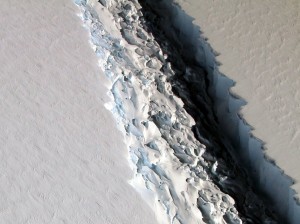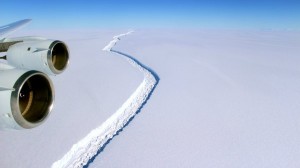A Really Big Crack In An Antarctic Ice Shelf Just Got Bigger
From a News Report of WAMU, Rae Ellen Bichell, National Public Radio, January 6, 2017
Right now, a big chunk of Antarctic ice is hanging on by a frozen thread. British researchers monitoring the crack in the Larsen C ice shelf say that only about 12 miles now connect the chunk of ice to the rest of the continent.
“After a few months of steady, incremental advance since the last event, the rift grew suddenly by a further 18 km [11 miles] during the second half of December 2016,” wrote Adrian Luckman in a statement Thursday by the MIDAS Project, which is monitoring changes in the area.
The crack in question has been growing for years and is now a total of roughly 70 miles long. When the fissure reaches the far side of the shelf, an iceberg the size of Delaware will float off, leaving the Larsen C 10 percent smaller.
A NASA scientist (John Sonntag) with project IceBridge took this photo of the crack in November.
“This event will fundamentally change the landscape of the Antarctic Peninsula,” Luckman wrote. Ice shelves are important because they provide a buffer between the sea and the ice that sits on land, in this case on the Antarctic Peninsula. Without a healthy ice shelf, water from melting glaciers can flow straight to the sea, raising the sea level.
It’s normal for the front of an ice shelf to crack and break off, known as calving. But it’s unusual for that to happen faster than the ice shelf can refreeze.
Some scientists worry that the missing piece will destabilize the whole ice shelf. A smaller ice shelf, Larsen B, completely splintered in a little over a month in 2002, a process that started with a similar crack. Another ice shelf, Larsen A, had disintegrated a few years before.
“Larsen C may eventually follow the example of its neighbour Larsen B,” wrote Luckman. Larsen C is Antarctica’s fourth-largest ice shelf.
“If it doesn’t go in the next few months, I’ll be amazed,” he told BBC News.
> > > > > > > > > > > >
Nearly all coral reefs will be ruined by climate change
From an Article by Katie Herzog, The Grist, January 6, 2017
According to a study in the journal Nature Scientific Reports, 99 percent of the world’s reefs will be affected by coral bleaching by the end of this century if climate change continues apace.
When water is above ideal temperatures, coral expels the symbiotic algae that reside in its tissue and provide it with nutrients. This turns the reefs a ghostly white, and while the coral is not exactly dead at that point, it is more susceptible to disease — and death. A bleaching event on Australia’s Great Barrier Reef last year, for instance, left 67 percent of its shallow-water coral dead.
This isn’t just bad for the reefs themselves; it’s bad for the vast, biodiverse ecosystems that depend on them. That includes the humans who fish these reefs and who cater to reef-loving tourists. The National Marine Fisheries Service estimates that the commercial value of fisheries near coral reefs is over $100 million in the U.S. alone, and reef-related tourism generates billions of dollars a year.
Even if aggressive actions are taken to combat climate change, such as those pledged during the Paris climate talks, it could be too late to prevent mass bleaching events at many reefs, according to the study. Divers, you might want to book those trips sooner rather than later.



{ 1 comment… read it below or add one }
Antarctic’s past points to current sea level threat
Article by Tim Radford, Climate News Network, January 9, 2017
PHOTO: Global warming is causing land-based ice to melt in parts of Antarctica such as the Weddell Sea region.
Evidence of Antarctic ice sheet melting and sea level rise almost 15,000 years ago raises alarm over current climate change dangers.
LONDON, 9 January, 2017 – Scientists have identified a fearful lesson from the past. Some 14,700 years ago, the Antarctic continent experienced a warm phase, when ice sheets melted and the global sea level rose by three metres.
And they warn that it could happen again, as conditions in the southern ocean that triggered the bygone event are being repeated.
Changes in ocean-atmosphere circulation have left the southern ocean stratified − a cold layer at the surface, and a warmer ocean lapping the base of the ice below. And this is making the ice sheets melt more strongly, the scientists say in Scientific Reports journal.
“The changes that are currently taking place in a disturbing manner resemble those 14,700 years ago,” says one of the authors, Michael Weber, an expert in paleoclimatology, geology and oceanography at the University of Bonn, Germany.
Land-based ice
And Chris Fogwill, senior research associate at the Climate Change Research Centre at the University of New South Wales, Australia, who led the study, says: “The reason for the layering is that global warming in parts of Antarctica is causing land-based ice to melt, adding massive amounts of cool freshwater to the ocean surface.
“At the same time as the surface is cooling, the deeper ocean is warming, which has already accelerated the decline of glaciers in the Amundsen Sea embayment. It appears global warming is replicating conditions that, in the past, triggered significant shifts in the stability of the Antarctic ice sheet.”
The team had been examining cores drilled from the Antarctic ice to “read” the pattern of temperatures of the past.
Earlier research, based on deep sea sediments deposited between the last Ice Age and the present warm period, has found evidence of eight melting events in the region, the largest occurring 14,700 years ago.
Melting ice delivers fresh water to the oceans. This makes the formation of sea ice more likely, and this same interplay between melting ice and the formation of more sea ice has been confirmed by other studies.
“The big question is whether the ice sheet will
react to these changing ocean conditions
as rapidly as it did 14,000 years ago”
The latest finding counts as an alarm signal rather than a prediction. It is, however, only the latest in a series of reports that the Antarctic ice cap is responding to global warming as a consequence of rising carbon dioxide levels in the atmosphere.
In the last two or three years, scientists have repeatedly warned that a warming ocean could accelerate the melt of sea ice and then of the land-based glaciers of the continent.
Sea level rise
They have pinpointed mechanisms that could be causing the ice shelf to break up, and they have even warned that loss of ice could cause a sea level rise of three metres.
So the latest study is a confirmation of familiar anxieties, but this time the researchers have pinpointed a feedback mechanism that might trigger melting.
They based their findings on analysis of the chemical isotopes locked in ancient ice from the Weddell Sea embayment, and the evidence suggests that in the past, when polar waters became more stratified, the ice sheets melted much more quickly.
What happened in the past could happen again. The process near the end of the last Ice Age took perhaps 300 years. In geological terms, this is rapid. More disconcertingly, once such a process starts, there is no obvious reason why it should stop.
“The big question,” says Nick Golledge, senior research fellow at the Antarctic Research Centre at Victoria University in New Zealand, “is whether the ice sheet will react to these changing ocean conditions as rapidly as it did 14,000 years ago.” – Climate News Network
About author – Tim Radford, a founding editor of Climate News Network, worked for The Guardian for 32 years, for most of that time as science editor. He has been covering climate change since 1988.
Source: http://climatenewsnetwork.net/antarctic-past-sea-level-threat/
See also: http://www.FrackCheckWV.net